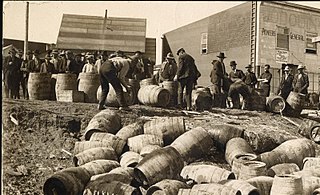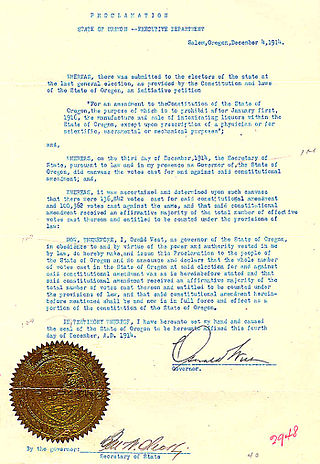
Prohibition is the act or practice of forbidding something by law; more particularly the term refers to the banning of the manufacture, storage, transportation, sale, possession, and consumption of alcoholic beverages. The word is also used to refer to a period of time during which such bans are enforced.

The Eighteenth Amendment to the United States Constitution established the prohibition of alcohol in the United States. The amendment was proposed by Congress on December 18, 1917, and ratified by the requisite number of states on January 16, 1919. The Eighteenth Amendment was repealed by the Twenty-first Amendment on December 5, 1933, making it the only constitutional amendment in American history to be repealed.

The National Prohibition Act, known informally as the Volstead Act, was an act of the 66th United States Congress designed to execute the 18th Amendment which established the prohibition of alcoholic drinks. The Anti-Saloon League's Wayne Wheeler conceived and drafted the bill, which was named after Andrew Volstead, chairman of the House Judiciary Committee, who managed the legislation.

The Twenty-first Amendment to the United States Constitution repealed the Eighteenth Amendment to the United States Constitution, which had mandated nationwide prohibition on alcohol. The Twenty-first Amendment was proposed by the 72nd Congress on February 20, 1933, and was ratified by the requisite number of states on December 5, 1933. It is unique among the 27 amendments of the U.S. Constitution for being the only one to repeal a prior amendment, as well as being the only amendment to have been ratified by state ratifying conventions.

The Blaine Act, formally titled Joint Resolution Proposing the Twenty-First Amendment to the United States Constitution, is a joint resolution adopted by the United States Congress on February 20, 1933, initiating repeal of the 18th Amendment to the United States Constitution, which established Prohibition in the United States. Repeal was finalized when the 21st Amendment to the Constitution was ratified by the required minimum number of states on December 5, 1933.
The Ontario Temperance Act was a law passed in 1916 that led to the prohibition of alcohol in Ontario, Canada. When the Act was first enacted, the sale of alcohol was prohibited, but liquor could still be manufactured in the province or imported. Strong support for prohibition came from religious elements of society such as the Ontario Woman's Christian Temperance Union, which sought to eliminate what it considered the societal ills and vices associated with liquor consumption, including violent behaviour and familial abuse. Historically, prohibition advocates in Ontario drew inspiration from the temperance movements in Britain and the United States. The Act was repealed in 1927.
The Canada Temperance Act, also known as the Scott Act, was an Act of the Parliament of Canada passed in 1878, which provided for a national framework for municipalities to opt in by plebiscite to a scheme of prohibition. It was repealed in 1984.

Prohibition in Canada was a ban on alcoholic beverages that arose in various stages, from local municipal bans in the late 19th century, to provincial bans in the early 20th century, and national prohibition from 1918 to 1920. The relatively large and powerful beer and alcohol manufacturing sector, and the huge working class that purchased their products, failed to convince any of the governments to reverse their stance on prohibition. Most provinces repealed their bans in the 1920s, though alcohol was illegal in Prince Edward Island from 1901 to 1948. By comparison, the Ontario Temperance Act was in effect from 1916 to 1927.
A plebiscite on the legality of alcoholic beverages was held in Ontario, Canada on January 1, 1894. Per the terms of the Prohibition Plebiscite Act passed in 1893, a plebiscite was held on the issue of prohibition in conjunction with the 1894 municipal elections. Though a majority of voters indicated support for prohibition, the results were non-binding and prohibition would not occur in Ontario until 1916.
A referendum on the legality of alcoholic beverages was held in Ontario, Canada on December 4, 1902. Though 65 percent of voters indicated support for prohibition, a majority of half of the number of voters in the 1898 election did not support the motion, and prohibition was not introduced.
A referendum was held in Ontario, Canada on April 18, 1921, concerning a ban on the importation of alcoholic beverages into the province. The referendum passed, and an importation ban was implemented.
A referendum was held on October 23, 1924 on the repeal of the Ontario Temperance Act. The referendum was brought about by a clause in the Act, which permitted the possible repeal of prohibition by a majority vote. The referendum upheld prohibition, albeit by the narrowest majority of all of Ontario's prohibition referendums; in 1927, prohibition would be repealed with the passing of the Liquor Licence Act.

The alcohol laws of Kansas are among the strictest in the United States, in sharp contrast to its neighboring state of Missouri, and similar to its other neighboring state of Oklahoma. Legislation is enforced by the Kansas Division of Alcoholic Beverage Control.
The Quebec referendum on the prohibition of alcohol, held on April 10, 1919, considered the legalization of the sale of beer, cider and wine in the province of Quebec, Canada. The 'yes' side won with 78.62% of the votes.

The U.S. state of Oregon has an extensive history of laws regulating the sale and consumption of alcoholic beverages, dating back to 1844. It has been an alcoholic beverage control state, with the Oregon Liquor and Cannabis Commission holding a monopoly over the sale of all distilled beverages, since Prohibition. Today, there are thriving industries producing beer, wine, and liquor in the state. Alcohol may be purchased between 7 a.m. and 2:30 a.m for consumption at the premise it was sold at, or between 6 a.m. and 2:30 a.m. if it is bought and taken off premise. In 2020, Oregon began allowing the sale of alcohol via home delivery services. As of 2007, consumption of spirits was on the rise while beer consumption held steady. That same year, 11% of beer sold in Oregon was brewed in-state, the highest figure in the United States.
Canadian liquor plebiscites, held in 1920 under the Canada Temperance Act and the Dominion Elections Act, were referendums on the strengthening of the Prohibition measures in effect in several provinces of Canada. Voters were asked if they supported banning of importation of liquor across provincial boundaries. The referendums were held on July 10, 1920, in New Brunswick; on October 20 in British Columbia; and on October 25 in Alberta, Manitoba, Nova Scotia, and Saskatchewan.

A number of referendums on alcohol licensing were held in New Zealand between 2 December 1894 and 15 August 1987. Because of their differing questions and rules, these referendums can be broken down into three time periods divided by what options were presented to voters.

The Dominion Alliance for the Total Suppression of the Liquor Traffic was an organization established in 1877 in Canada that lobbied for prohibition of alcohol. Membership was largely Protestant and Anglophone. The Dominion Alliance faced passive resistance from politicians concerned about the views of their constituents, particularly in Quebec, but had some success at the local level. Sale of alcohol was prohibited provincially and then nationally during World War I (1914–18). After the war the national and provincial temperance laws were repealed and the Dominion Alliance faded into irrelevance.

BC Liquor Stores are a chain of government-owned and operated retail outlets operated by the British Columbia Liquor Distribution Branch to distribute alcoholic beverages in the province of British Columbia, Canada. They are accountable to the Attorney General of British Columbia. BC Liquor Stores currently operate 198 locations across the province. The chain was established in June 1921, following the result of a plebiscite in favour of liquor availability through government liquor stores. Prior to the plebiscite, alcohol had been illegal through the Prohibition Act, introduced on May 23, 1916, with exceptions for sacramental, medicinal or industrial purposes.
In the Canadian province of Ontario, severe restrictions on the sale and consumption of alcoholic drink were imposed in localities during the later 19th century. Prohibition was imposed across the province under the 1916 Ontario Temperance Act, until restrictions were somewhat eased with the passage of the Liquor Control Act of 1927 which set up the still existing Liquor Control Board of Ontario. Regulations were further amended in 1934.










